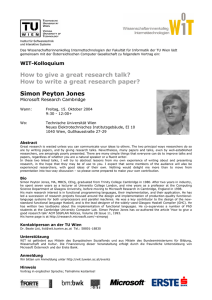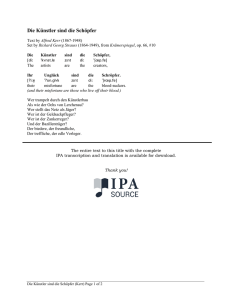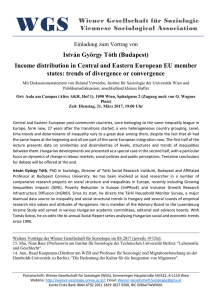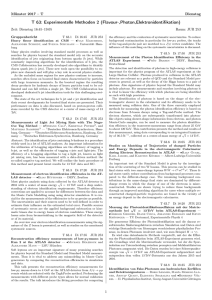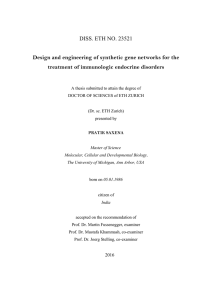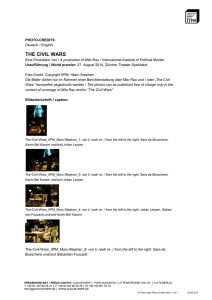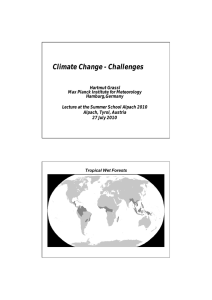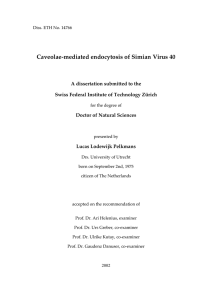3. Vorlesung Immunologie
Werbung
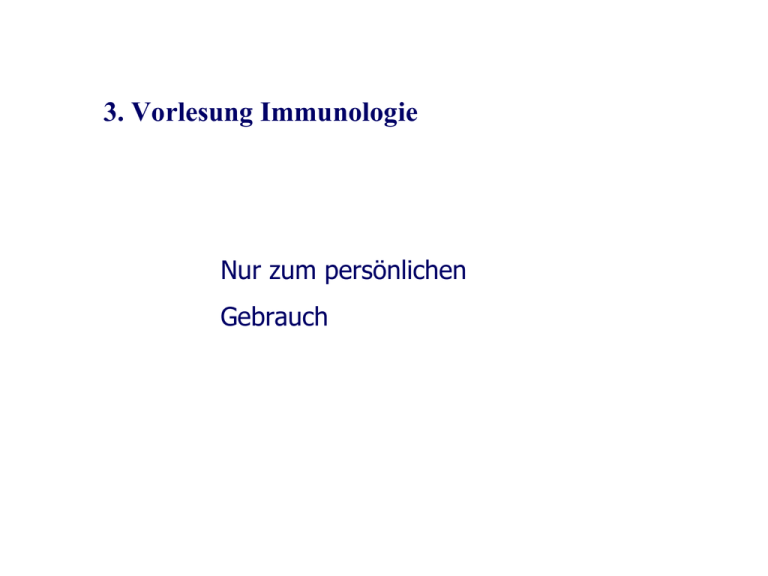
3. Vorlesung Immunologie Nur zum persönlichen Gebrauch 3. Vorlesung Immunologie Einführung - Angeborene und erworbene Immunität Zellen und Organe des Immunsystems Reifung der Lymphozyten - Apoptose Antikörper (Ak) - Entstehung der Ak-Variabilität Herstellung und Nutzung von Antikörpern T-Zell-Rezeptoren (TcR) und T-Zellen MHC (major histocompatibility complex) -Moleküle Regulationsmechanismen (Vermeidung von Reaktionen gegen "Selbst") Phylogenese der spezifischen Immunmechanismen Zusammenfassung: Immunologie I; 2. Vorlesung (1/1) 1. Komponenten der angeborenen Immunität sind äußere Barrieren (Haut), phagozytierende Zellen, lösliche Moleküle etc. 2. Die Rezeptoren der angeborenen Immunität (wie z.B. die TLR) werden von Keimbahn-Genen kodiert. 3. Zu den löslichen Komponenten der angeborenen Immunität gehören Akute-Phase-Proteine, das Komplement-System, Interferone etc. 4. Die wichtigsten Charakteristika der erworbenen Immunität sind: a. Unterscheidung von Selbst und Fremd, b. Vielfalt und Spezifität, c. Adaptivität, d. Gedächtnis. 5. Das immunologische Gedächtnis ermöglicht die Vakzinierung gegen Infektionserreger. Fig. 1.2 The eradication of smallpox by vaccination Mr. John Wickett, of the World Health Organization, with the last person to have contracted – and survived – naturally occurring smallpox (hospital cook Ali Maow Maalim in Merka, Somalia, on October 26, 1977). courtesy Mr. John Wickett. Somalia, 1977 Ali Maalim, last recorded case of naturally-caused smallpox http://www.cdc.gov/od/ogh/smallmaa.htm ● 2002 - Health experts blamed rise of measles cases on poor uptake of MMR vaccine ● 2005 - Mumps epidemic mainly affected 13-24 year-olds who were too old to have had MMR vaccine as children ► Complications of mumps ◄ 1 in 25: Deafness - usually with partial or complete recovery 1 in 30: Pancreatitis Hospital admission Mumps during pregnancy can cause miscarriage Quellen: http://news.bbc.co.uk/1/hi/health/7314144.stm http://news.bbc.co.uk/2/hi/health/3643676.stm Fig. 1.19 The principle of vaccination is illustrated by immunization with diphtheria toxoid. Chemical modification of diptheria toxin produces a toxoid which has lost toxicity but retains its epitopes. Thus, a primary antibody response to these epitopes is produced following vaccination with toxoid. In a natural infection the toxin re-stimulates B memory cells, which produce the faster and more intense secondary antibody response to the epitope, so neutralizing the toxin. Roitt, Brostoff & Male: Immunology. 5th ed. Mosby1998 Zellen des Immunsystems ● Phagozyten, weitere Leukozyten, ● Antigen-präsentierende Zellen ● T- & B-Lymphozyten (klonale Selektion) sie sind Träger und Produzenten der „spezifischen“ Rezeptoren Lymphozyten mit spezifischen Rezeptoren T-Lymphozyten B-Lymphozyten B-Zellen produzieren Antikörper TH1-Zellen aktivieren Makrophagen TH2-Zellen aktivieren B-Zellen TC-Zellen TR/S-Zellen töten Virusregulieren andere infizierte Zellen Immunzellen erkennen fremde Antigene; Rezeptoren sind durch somatisch rekombinierte Gene kodiert Fig. 1.5 Lymphocytes are mostly small and inactive cells The left panel shows a light micrograph of a small Iymphocyte in which the nucleus has been stained purple by the hematoxylin and eosin dye, surrounded by red blood cells (which have no nuclei). Note the darker purple patches of condensed chromatin of the Iymphocyte nucleus, indicating little transcriptional activity, the relative absence of cytoplasm, and the small size. The right panel shows a transmission electron micrograph of a small Iymphocyte. Again, note the evidence of functional inactivity: the condensed chromatin, the scanty cytoplasm, and the absence of rough endoplasmic reticulum. Photographs courtesy of N. Rooney. „Spezifische“ Rezeptoren der erworbenen Immunabwehr B-Zell-Rezeptoren - Immunglobuline (Ig), Antikörper T-Zell-Rezeptoren - zellständige Abwehrmoleküle Variabilität entsteht in jedem Individuum auf somatischer Ebene naïve Zellen ausdifferenzierte Zellen B-Lymphozyt Plasmazelle lösl. Produkte Antikörper Rezeptoren Oberflächen-Ig T-Lymphozyt keine Oberfl.-Ig, lösl. Ig = Ak EffektorT-Lymphozyt Zytokine, Perforine, Granzyme etc. Rezeptoren TcR TcR Fig. 1.3 All the cellular elements of the blood, including the cells of the immune system, arise from pluripotent hematopoietic stem cells in the bone marrow. Lymphatische Organe Primäre lymphatische Organe: Thymus, Bursa fabricii, Knochenmark Sekundäre lymphatische Organe: Milz, Lymphknoten, Peyersche Plaques, Tonsillen, Appendix, Mucosa-assoziiertes Gewebe, Lymphbahnen, zirkulierende Lymphozyten (1 - 5 x 1011 Zellen/Tag), Lymphbahnen, Blut Roitt, Brostoff & Male: Immunology. 5th ed. Mosby1998 Fig. 1.2 The major lymphoid organs of the mouse Blut: 5-11 x 106 Lymphozyten Hudson & Hay: Practical Immunology. 3rd ed. Blackwell 1991 aus: Practical Immunology. L. Hudson & F. C. Hay Lymphozyten mit spezifischen Rezeptoren T-Lymphozyten B-Lymphozyten B-Zellen produzieren Antikörper TH1-Zellen aktivieren Makrophagen TH2-Zellen aktivieren B-Zellen TC-Zellen TR/S-Zellen töten Virusregulieren andere infizierte Zellen Immunzellen erkennen fremde Antigene; Rezeptoren sind durch somatisch rekombinierte Gene kodiert Fig. 7.10 The thymus is critical for the maturation of bone marrow derived cells into T cells. Mice with the scid mutation have a defect that prevents lymphocyte maturation, whereas mice with the nude mutation have a defect that affects the development of the cortical epithelium of the thymus. T cells do not develop in either strain of mouse: this can be demonstrated by staining spleen cells with antibodies specific for mature T cells and analyzing them in a flow cytometer, as represented by the blue line in the graphs in the bottom panels. Bone marrow cells from nude mice can restore T cells to scid mice (red line in graph on left), showing that, in the correct environment, the nude bone marrow cells are intrinsically normal and capable of producing T cells. Thymic epithelial cells from scid mice can induce the maturation of T cells in nude mice (red line in graph on right), demonstrating that the thymus provides the essential microenvironment for T-cell development. Längsschnitt durch Knochen von Säugetier und Vogel C. Perrins, Pareys Naturführer Plus Vögel, Parey, Hamburg , 1987 Primary lymphatic organs Secondary lymphatic organs Thymus T lymphocyte with specific receptors against foreign antigens and self MHCs Bone marrow Bone marrow Stem cells; lymphatic precursor cells Lymphocytes are provided with random receptors one cell receives receptors of one specificity Deletion of autoreactive cells B lymphocyte with specific receptors against foreign antigens Fig. 7.15 The cellular organization of the human thymus. Migrationsrichtung der Thymozyten Fig. 12.12 (1) Low-power scanning electron micrograph showing the architecture of bone and its relationship to bone marrow. A cavity has been picked out and is drawn schematically on the right. (2) Within the cavities of spongy bone, B-cell lymphopoiesis takes place, with maturation occurring in a radial direction towards the centre (from the endosteum to the central venous sinus). Immature progenitor cells adjacent to the endosteal cell layer mature into pre-B cells, many of which die and are phagocytosed by bone-marrow macrophages containing tingible bodies. Cells which survive mature further and reach the central venous sinus. Association with stromal cells, and the presence of cytokines such as IL-7, are essential for all steps of B-cell maturation. Roitt, Brostoff & Male: Immunology. 5th ed. Mosby1998 2. “Vermeidung" von Reaktionen gegen "selbst" (eine Art „Selbsterkennen“) 2.1. Schutzmechanismen a) Schutzmoleküle an Zelloberflächen (z.B. CD59 -Protectin), um Komplementaktivierung zu verhindern 2.2. Erkennung von "selbst“, um Reaktionen gegen "selbst" zu verhindern a) Erkennung von MHC-Molekülen durch NK cells (KIR) b) Erkennung von CD47 durch Makrophagen (SIRPα) 2.3. Toleranz und Regulationsmechnanismen a) Elimininierung von selbst-reaktiven B- und TLymphozyten in den primären lymphatischen Organen (“Lernprozess“) b) Regulation der Aktivität der B- und T-Lymphozyten

